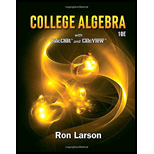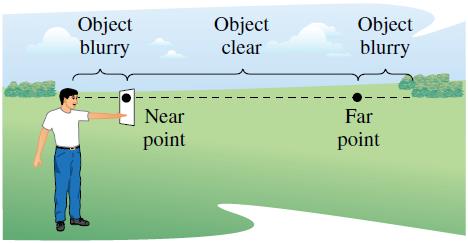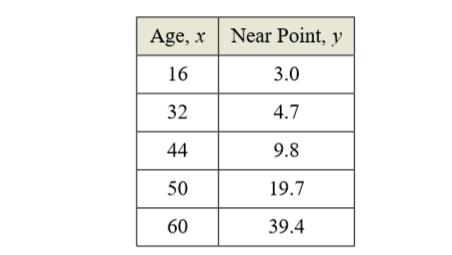
Concept explainers
Distinct Vision The endpoints of the interval over which distinct vision is possible are called the near point and far point of the eye (see figure). With increasing age, these points normally change. The table shows the approximate near points y (in inches) for various ages x (in years).


(a) Use the regression feature of a graphing utility to find a quadratic model for the data. Use the graphing utility to plot the data and graph the model in the same viewing window.
(b) Find a rational model for the data. Take the reciprocals of the near points to generate the points
Solve for y. Use the graphing utility to plot the original data and graph the model in the same viewing window.
(c) Use the table feature of the graphing utility to construct a table showing the predicted near point based on each model for each of the ages in the original table. How well do the models fit the original data?
(d) Use both models to estimate the near point for a person who is 25 years old. Which model
is a better fit?
(e) Do you think either model can be used to predict the near point for a person who is 70
years old? Explain.
Trending nowThis is a popular solution!

Chapter 4 Solutions
College Algebra
- There are 15 candidates running for any of 5 distinct positions on the local school board. In how many different ways could the 5 positions be filled?arrow_forwardCelina is picking a new frame for a custom piece of artwork. She has to select a frame size, material, and color. There are four different frame sizes, three different frame materials, and six different frame colors. She must chose one option only from each category. How many different possible frames could Celina pick from?arrow_forwardA research study in the year 2009 found that there were 2760 coyotes in a given region. The coyote population declined at a rate of 5.8% each year. How many fewer coyotes were there in 2024 than in 2015? Explain in at least one sentence how you solved the problem. Show your work. Round your answer to the nearest whole number.arrow_forward
- please Solve questions by Course Name( Ordinary Differential Equations II 2)arrow_forwardInThe Northern Lights are bright flashes of colored light between 50 and 200 miles above Earth. Suppose a flash occurs 150 miles above Earth. What is the measure of arc BD, the portion of Earth from which the flash is visible? (Earth’s radius is approximately 4000 miles.)arrow_forwarde). n! (n - 1)!arrow_forward
- Algebra & Trigonometry with Analytic GeometryAlgebraISBN:9781133382119Author:SwokowskiPublisher:Cengage

 Glencoe Algebra 1, Student Edition, 9780079039897...AlgebraISBN:9780079039897Author:CarterPublisher:McGraw Hill
Glencoe Algebra 1, Student Edition, 9780079039897...AlgebraISBN:9780079039897Author:CarterPublisher:McGraw Hill  College AlgebraAlgebraISBN:9781305115545Author:James Stewart, Lothar Redlin, Saleem WatsonPublisher:Cengage Learning
College AlgebraAlgebraISBN:9781305115545Author:James Stewart, Lothar Redlin, Saleem WatsonPublisher:Cengage Learning Algebra and Trigonometry (MindTap Course List)AlgebraISBN:9781305071742Author:James Stewart, Lothar Redlin, Saleem WatsonPublisher:Cengage Learning
Algebra and Trigonometry (MindTap Course List)AlgebraISBN:9781305071742Author:James Stewart, Lothar Redlin, Saleem WatsonPublisher:Cengage Learning





